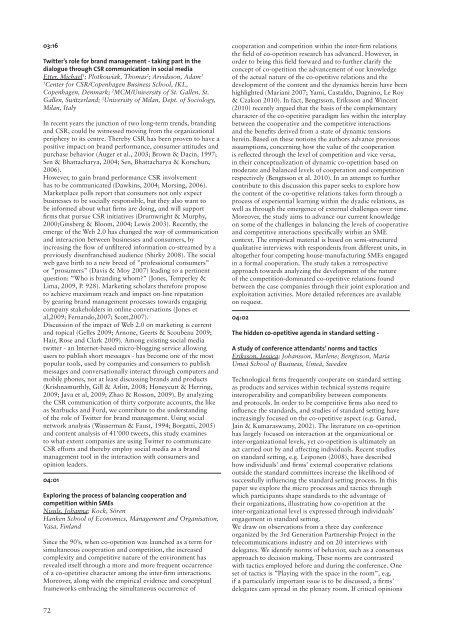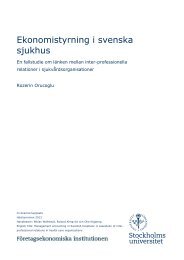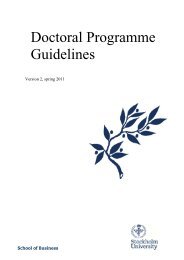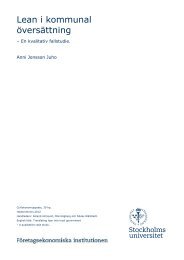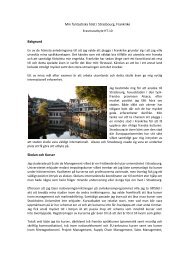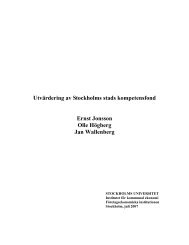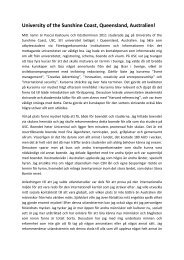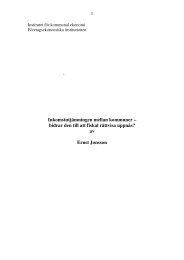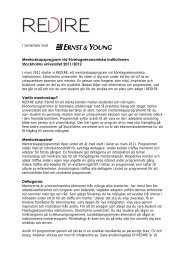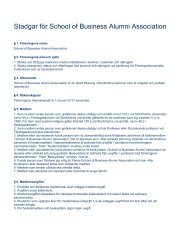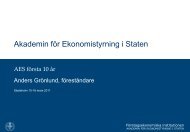Download full programme and abstract book pdf 1.6
Download full programme and abstract book pdf 1.6
Download full programme and abstract book pdf 1.6
Create successful ePaper yourself
Turn your PDF publications into a flip-book with our unique Google optimized e-Paper software.
03:16<br />
Twitter’s role for br<strong>and</strong> management - taking part in the<br />
dialogue through CSR communication in social media<br />
Etter, Michael 1 ; Plotkowiak, Thomas 2 ; Arvidsson, Adam 3<br />
1 Center for CSR/Copenhagen Business School, IKL,<br />
Copenhagen, Denmark; 2 MCM/University of St. Gallen, St.<br />
Gallen, Switzerl<strong>and</strong>; 3 University of Milan, Dept. of Sociology,<br />
Milan, Italy<br />
In recent years the junction of two long-term trends, br<strong>and</strong>ing<br />
<strong>and</strong> CSR, could be witnessed moving from the organizational<br />
periphery to its centre. Thereby CSR has been proven to have a<br />
positive impact on br<strong>and</strong> performance, consumer attitudes <strong>and</strong><br />
purchase behavior (Auger et al., 2003; Brown & Dacin, 1997;<br />
Sen & Bhattacharya, 2004; Sen, Bhattacharya & Korschun,<br />
2006).<br />
However, to gain br<strong>and</strong> performance CSR involvement<br />
has to be communicated (Dawkins, 2004; Morsing, 2006).<br />
Marketplace polls report that consumers not only expect<br />
businesses to be socially responsible, but they also want to<br />
be informed about what firms are doing, <strong>and</strong> will support<br />
firms that pursue CSR initiatives (Drumwright & Murphy,<br />
2000;Ginsberg & Bloom, 2004; Lewis 2003). Recently, the<br />
emerge of the Web 2.0 has changed the way of communication<br />
<strong>and</strong> interaction between businesses <strong>and</strong> consumers, by<br />
increasing the flow of unfiltered information co-streamed by a<br />
previously disenfranchised audience (Shirky 2008). The social<br />
web gave birth to a new breed of ”professional consumers”<br />
or ”prosumers” (Davis & Moy 2007) leading to a pertinent<br />
question: ”Who is br<strong>and</strong>ing whom?” (Jones, Temperley &<br />
Lima, 2009, P. 928). Marketing scholars therefore propose<br />
to achieve maximum reach <strong>and</strong> impact on-line reputation<br />
by gearing br<strong>and</strong> management processes towards engaging<br />
company stakeholders in online conversations (Jones et<br />
al,2009; Fern<strong>and</strong>o,2007; Scott,2007).<br />
Discussion of the impact of Web 2.0 on marketing is current<br />
<strong>and</strong> topical (Gelles 2009; Arnone, Geerts & Scoubeau 2009;<br />
Hair, Rose <strong>and</strong> Clark 2009). Among existing social media<br />
twitter - an Internet-based micro-blogging service allowing<br />
users to publish short messages - has become one of the most<br />
popular tools, used by companies <strong>and</strong> consumers to publish<br />
messages <strong>and</strong> conversationally interact through computers <strong>and</strong><br />
mobile phones, not at least discussing br<strong>and</strong>s <strong>and</strong> products<br />
(Krishnamurthly, Gill & Arlitt, 2008; Honeycutt & Herring,<br />
2009; Java et al, 2009; Zhao & Rosson, 2009). By analyzing<br />
the CSR communication of thirty corporate accounts, the like<br />
as Starbucks <strong>and</strong> Ford, we contribute to the underst<strong>and</strong>ing<br />
of the role of Twitter for br<strong>and</strong> management. Using social<br />
network analysis (Wasserman & Faust, 1994; Borgatti, 2005)<br />
<strong>and</strong> content analysis of 41’000 tweets, this study examines<br />
to what extent companies are using Twitter to communicate<br />
CSR efforts <strong>and</strong> thereby employ social media as a br<strong>and</strong><br />
management tool in the interaction with consumers <strong>and</strong><br />
opinion leaders.<br />
04:01<br />
Exploring the process of balancing cooperation <strong>and</strong><br />
competition within SMEs<br />
Nisuls, Johanna; Kock, Sören<br />
Hanken School of Economics, Management <strong>and</strong> Organisation,<br />
Vasa, Finl<strong>and</strong><br />
Since the 90’s, when co-opetition was launched as a term for<br />
simultaneous cooperation <strong>and</strong> competition, the increased<br />
complexity <strong>and</strong> competitive nature of the environment has<br />
revealed itself through a more <strong>and</strong> more frequent occurrence<br />
of a co-opetitive character among the inter-firm interactions.<br />
Moreover, along with the empirical evidence <strong>and</strong> conceptual<br />
frameworks embracing the simultaneous occurrence of<br />
72<br />
cooperation <strong>and</strong> competition within the inter-firm relations<br />
the field of co-opetition research has advanced. However, in<br />
order to bring this field forward <strong>and</strong> to further clarify the<br />
concept of co-opetition the advancement of our knowledge<br />
of the actual nature of the co-opetitive relations <strong>and</strong> the<br />
development of the content <strong>and</strong> the dynamics herein have been<br />
highlighted (Mariani 2007; Yami, Castaldo, Dagnino, Le Roy<br />
& Czakon 2010). In fact, Bengtsson, Eriksson <strong>and</strong> Wincent<br />
(2010) recently argued that the basis of the complementary<br />
character of the co-opetitive paradigm lies within the interplay<br />
between the cooperative <strong>and</strong> the competitive interactions<br />
<strong>and</strong> the benefits derived from a state of dynamic tensions<br />
herein. Based on these notions the authors advance previous<br />
assumptions, concerning how the value of the cooperation<br />
is reflected through the level of competition <strong>and</strong> vice versa,<br />
in their conceptualization of dynamic co-opetition based on<br />
moderate <strong>and</strong> balanced levels of cooperation <strong>and</strong> competition<br />
respectively (Bengtsson et al. 2010). In an attempt to further<br />
contribute to this discussion this paper seeks to explore how<br />
the content of the co-opetitive relations takes form through a<br />
process of experiential learning within the dyadic relations, as<br />
well as through the emergence of external challenges over time.<br />
Moreover, the study aims to advance our current knowledge<br />
on some of the challenges in balancing the levels of cooperative<br />
<strong>and</strong> competitive interactions specifically within an SME<br />
context. The empirical material is based on semi-structured<br />
qualitative interviews with respondents from different units, in<br />
altogether four competing house-manufacturing SMEs engaged<br />
in a formal cooperation. The study takes a retrospective<br />
approach towards analyzing the development of the nature<br />
of the competition-dominated co-opetitive relations found<br />
between the case companies through their joint exploration <strong>and</strong><br />
exploitation activities. More detailed references are available<br />
on request.<br />
04:02<br />
The hidden co-opetitive agenda in st<strong>and</strong>ard setting -<br />
A study of conference attendants’ norms <strong>and</strong> tactics<br />
Eriksson, Jessica; Johansson, Marlene; Bengtsson, Maria<br />
Umeå School of Business, Umeå, Sweden<br />
Technological firms frequently cooperate on st<strong>and</strong>ard setting<br />
as products <strong>and</strong> services within technical systems require<br />
interoperability <strong>and</strong> compatibility between components<br />
<strong>and</strong> protocols. In order to be competitive firms also need to<br />
influence the st<strong>and</strong>ards, <strong>and</strong> studies of st<strong>and</strong>ard setting have<br />
increasingly focused on the co-opetitive aspect (e.g. Garud,<br />
Jain & Kumaraswamy, 2002). The literature on co-opetition<br />
has largely focused on interaction at the organizational or<br />
inter-organizational levels, yet co-opetition is ultimately an<br />
act carried out by <strong>and</strong> affecting individuals. Recent studies<br />
on st<strong>and</strong>ard setting, e.g. Leiponen (2008), have described<br />
how individuals’ <strong>and</strong> firms’ external cooperative relations<br />
outside the st<strong>and</strong>ard committees increase the likelihood of<br />
success<strong>full</strong>y influencing the st<strong>and</strong>ard setting process. In this<br />
paper we explore the micro processes <strong>and</strong> tactics through<br />
which participants shape st<strong>and</strong>ards to the advantage of<br />
their organizations, illustrating how co-opetition at the<br />
inter-organizational level is expressed through individuals’<br />
engagement in st<strong>and</strong>ard setting.<br />
We draw on observations from a three day conference<br />
organized by the 3rd Generation Partnership Project in the<br />
telecommunications industry <strong>and</strong> on 20 interviews with<br />
delegates. We identify norms of behavior, such as a consensus<br />
approach to decision making. These norms are contrasted<br />
with tactics employed before <strong>and</strong> during the conference. One<br />
set of tactics is ”Playing with the space in the room”, e.g.<br />
if a particularly important issue is to be discussed, a firms’<br />
delegates cam spread in the plenary room. If critical opinions


